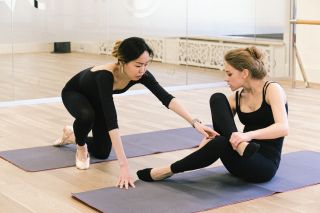Education
What We Can Learn from Women Who Take Adult Ballet Classes
Research demonstrates that ballet can bring holistic benefits for exercisers.
Posted February 22, 2023 Reviewed by Devon Frye
Key points
- Recreational ballet dancing provides physical and cognitive benefits.
- Dancing ballet at a mature age can help someone stay physically and mentally healthy while defying negative aging stereotypes.
- Learning ballet techniques is an enjoyable challenge for many participants, improving their confidence and sense of self.
- Learning new physical skills can add to the enjoyment of any exercise.
As the world’s population ages, exercise advice targeting older adults has become more popular. Social dance, specifically, has been considered a good exercise for those of increasing age because it can improve posture, balance, and mobility, as well as cognitive abilities.
But what about ballet, a type of dance widely thought to require extreme physical ability? Who would attempt to learn ballet in their later years? Yet perhaps surprisingly, there are a number of mature women who choose to attend ballet classes taught by professional ballet companies or dance studios—and researchers are starting to examine their experiences.
Using an approach called action research, Anja Ali-Haapala, Gene Moyle, and Graham Kerr studied a ballet class offered for women aged between 46 and 82 years with a professional company and professional ballet teachers in Australia. Likewise, Allison Jeffrey, Corrine Story, and I interviewed participants in a recreational ballet class offered to women 55+ years by a local ballet company with a professional ballet teacher in Canada. A third study, by Rachyl Pines and Howard Giles, included adult ballet classes at local studios in the United States. In this study, the dancers’ ages ranged from 23 to 87 years old, with some retiring from their ballet careers at an early age.
Although the participants’ ballet experience differed from retired professional dancers to total beginners, several main themes emerged across all three studies.
The Physical and Mental Challenges of Dancing Ballet
All of the dancers interviewed for these studies cherished the physical challenge offered by ballet. Although cardiovascular "exertion" was mentioned, many participants referred to the technical aspects of dancing ballet when discussing its physicality. The ballet technique, they indicated, improved balance and flexibility and also required them to train muscles not usually used during everyday life.

A typical ballet class included both barre work and exercises in the center of the floor. Jeffrey and colleagues found that the participants considered the barre work particularly helpful in the recreational class. One dancer explained that her “favorite was the barre, some of the leg lifts, and the things that really got at those new muscles that I don’t often use” (p. 6).
The more experienced ballet dancers enjoyed the physical challenge of the center work including the choreographed sequences. In Ali-Haapala and colleagues’ study, the dancers wanted to be “‘extended’ through ballet’s technique” (p. 5) and to continue improving their dance ability. Instead of a steady decline, the dancers believed they could keep developing their ballet skills. As one woman in Pines and Giles’ study explained: “I always felt like there was a chance to move and do something better... maybe this tonight or tomorrow I can do a pirouette that I hadn’t done in a while… [or] my extension is going to be better” (p. 87).
Remembering the movement sequences, changing directions, and learning the choreographed sequences presented further challenges to the dancers in Ali-Haapala and colleagues' study. As one dancer explained: “The holding of the pattern, taking in that information and then getting yourself going with the music, and even remembering what’s the first step” (p. 4) required particular concentration.
The recreational ballet dancers in Jeffrey and colleagues’ study also found that their class was mentally stimulating. One dancer concluded: “those exercises [help] me to focus and to try to remember the sequence of things that I’ve done… the overall effect of exercise… [is] a really big deal” (p. 7).

Regardless of their previous ballet experience, all the dancers felt empowered to modify the exercises to match their own needs. Linda explained that in her recreational ballet class, “there were some things I just couldn’t do, and the balance pieces were really challenging for me, which shows me how much work I need to do… some days you’re better than others” (Jeffrey & al., 2022, p. 8).
Gaining a Sense of Self
Although the dancers were not always prepared to perform all the exercises in their classes, ballet increased their confidence. Recreational dancer Janice found that the ballet class improved self-awareness: “It [ballet] makes me feel more confident, it makes me feel like I can tackle more things. It makes me feel less like I’m aging. It makes me feel engaged and connected” (Jeffrey & al., 2022, p. 7).
Pines and Giles also observed that the dancers in their study self-identified as "ballet dancers" rather than "old." The women explained that dancing ballet sustained their energy levels and added “more than 10 years to your life and to your health” (p. 87). For these dancers, ballet was a way of expressing feelings and emotions through movement and also a central aspect of their identities.
The Pleasures of Dancing Ballet
All of the ballet dancers across the studies emphasized the enjoyment of dancing. The recreational dancers enjoyed “learning a little bit of ballet” (Jeffrey & al., 2022, p. 6). The advanced ballet dancers in Pines and Giles’ study danced because “it was so pleasurable” (p. 85).
Ali-Haapala and colleagues emphasized that ballet offered multiple pleasures to their participants. The dancers enjoyed the physical and cognitive challenges of the demanding ballet routines performed to music and even asked their teachers for more complicated exercises. In addition, they enjoyed the opportunity to dance for leisure and found pleasure in the aspects of ballet that were most suitable for each dancer.
Finally, they enjoyed the social aspects of dancing with other women of similar age. This aspect was also emphasized by the recreational ballet dancers in Jeffrey and colleagues’ study. One participant explained that while there were women of “all different sizes, body types, backgrounds,” they “were the same age and we weren’t in amongst a bunch of young girls and men who were checking themselves out in their lululemon outfits… it felt comfortable being amongst everybody” (p. 6).
Pines and Giles also observed that some of their participants had become good friends with their fellow dancers. In the studio classes open to all adults, these ballet dancers enjoyed the opportunity for intergenerational interactions to dance with much younger (age 23) and older (age 87) ballerinas with significant experience in ballet.
Lessons to Learn
These studies reported mature women’s experiences in ballet classes—but we can learn some further lessons from them, not only for seniors’ exercise classes but also for the fitness industry in general.
1. Instead of offering only easy-to-follow exercise classes, including opportunities to learn new skills can add interest in physical activity participation.
The ballet dancers embraced the physical challenges of learning ballet techniques that also invited them to think about what they were doing. This gave the dancers a better sense of self that also defied some of the social stereotypes of aging as a process of decline.
A ballet class became a space that offered ways to think of new opportunities for joy. Therefore, adding skill learning to any exercise class can be an important challenge that helps all fitness participants to defy social expectations of femininity.
2. Instead of hard work, emphasizing the enjoyment of exercise is important for continued participation.
The ballet dancers enjoyed being in their dance spaces, doing their exercises to music, and dancing with other dancers. Maintaining health was important and the dancers were not immune to body concerns. For example, having mirrors in the studios troubled some dancers.
However, the actual ballet movements and learning to skillfully execute them was the predominant source of pleasure. Consequently, focusing on the enjoyment of moving during any exercise class is important for participants’ positive exercise experience.

3. Instead of one size for all, exercise modifications need to be included in fitness classes.
The role of the teacher was important for the mature ballet dancers: it was the teacher who determined the content of the class and also provided some modifications for different levels of dancers. It is important to realize that mature women, or any women, are not a unified group who needs only gentle exercise; many also enjoy physical challenges. A well-educated instructor with appropriate qualifications can cater to the needs of a diverse clientele.
4. Not only the physical but also the social aspect of exercise participation is important.
Getting to know other women in the ballet class was important for many participants. Some dancers felt the most comfortable in a class with participants of similar ages; others enjoyed having a wide age range, but a similar skill level. However, it was important to have the possibility to dance at any age. Offering classes for a specific target group can be very empowering, but it is also important to consider exercisers' different skill levels.
Dancing ballet and learning new skills in older age can be enjoyable, creating confidence and a stronger sense of self. Some of its special qualities can be introduced to other exercise modalities targeting a wide variety of clients and to further increase participation in fitness.
References
Ali-Haapala, A., Moyle, G., & Kerr, Graham (2021). ‘Stretch’ cognitively and physically: A research on older adults’ experiences of taking ballet classes as an anti-aging method. Journal of Innovation in Social Science, 2(1), 1-7.
Jeffrey, A., Markula, P., & Story, C. (2022). Women’s articulations of aging: “Learning to be affected” through experiences in recreational ballet. Frontiers in Sports and Active Living, 4:795956. doi: 10.3389/fspor.2022.795956
Pines, R., & Giles, H. (2020). Dancing while aging: A study on benefits of ballet for older women. Anthropology & Aging, 41(1), 83-94. DOI 10.5195/aa.2020.209




